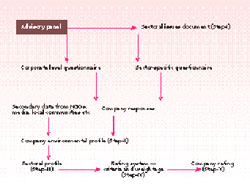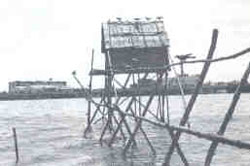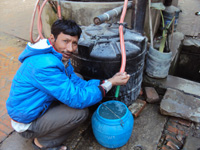
Maps of the world
Geographical Information Systems is revolutionising the present and portend a happier future. Or so we hope in the maps of our minds.

Geographical Information Systems is revolutionising the present and portend a happier future. Or so we hope in the maps of our minds.

After initial success in deriving energy from water, sun, wind and biomass, India is poised for a great leap in making these the energy sources of the future.
<font class='UCASE'><font color=red>S K Kabra</font></font> , associate professor in the paediatric pulmonology division of All India Institute of Medical Sciences, New Delhi talks to <font class='UCASE'><font color=red>Nidhi Jamwal</font></font> about

After generating a lot of scientific interest worldwide, neem is now attracting pesticide manufacturers and pharmaceuticals keen to exploit its various properties.

Indian farmers are busy harvesting the booming demand for mushrooms. The problem is that it is a delicacy that is rather fastidious about its growing requirements

The certainty about the first confirmed case of AIDS is over

The recent Supreme Court orders against polluting industries have merely kicked off an arduous process of cleaning up the Capital

Industry gets a new friend, philosopher and evaluator the Centre for Science and Environment s Green Rating Project, which will be the first instrument in the country to measure industrial firms on the basis of their eco friendliness

Industrialised countries uneasy at the prospect of a shift from traditional political rights for the individual to rights that link communities and the environment?

Real estate developers and government agencies are devouring the wetlands in communist ruled Calcutta
DTE sought the comments of legal luminaries and journalists on some issues that emerged out of this analysis. The individuals whose opinions appear here are P N Baghwati, former Chief Justice of India, A M Singhvi, additional solicitor general of India; R

<p><span style="font-size:14px;"><strong>Privatization of Water</strong></span></p> <p><img alt="" src="http://www.indiaenvironmentportal.org.in/files/country/nepal/private_water_hl.jpg" style="border-width: 2px; border-style: solid;" /></p> <p>The World Bank initiated water sector reforms aim primarily at privatizing water utilities and commercializing water resources. The water privatization policy of the World Bank articulated in a 1992 paper entitled “Improving Water Resources Management” proceeds from the belief that water availability at low or no cost is uneconomical and inefficient.</p>
<table border="0" cellpadding="0" cellspacing="0" width="210px"> <tbody> <tr> <td bgcolor="#363636" colspan="2" height="26px" style="color: rgb(255, 255, 255); font-size: 14px; padding-left:5px;"> Editor's Pick</td> </tr> </tbody> </table> <p><iframe frameborder="0" height="380" marginheight="0" marginwidth="0" scrolling="no" src="http://www.indiaenvironmentportal.org.in/files/country/bangladesh/bangladesh_iframe.htm" style="border-width:0px; border-color:#333; background:#FFF; border-style:solid;" width="555"></iframe></p> <hr /> <table border="0" cellpadding="0" cellspacing="0" width="210px"> <tbody> <tr> <td bgcolor="#363636" colspan="2" height="26px" style="color: rgb(255, 255, 255); font-size: 14px; padding-left:5px;"> Country Overview</td> </tr> </tbody> </table> <table border="0" cellpadding="1" cellspacing="1" style="width: 540px;"> <tbody bgcolor="#F0F0F0"> <tr> <td> <p><iframe align="right" frameborder="1" height="310" marginheight="0" marginwidth="0" scrolling="no" src="https://maps.google.co.in/maps?f=q&source=s_q&hl=en&geocode=&q=bangladesh&aq=&sll=20.984928,82.752628&sspn=45.458666,56.513672&ie=UTF8&hq=&hnear=Bangladesh&t=m&ll=23.684774,90.351563&spn=3.42031,3.724365&z=7&output=embed" width="330"></iframe><span style="font-family:arial,helvetica,sans-serif;"><span style="font-size: 12px;">Bangladesh is located between 20 º 34 to 26º 38 north latitude and 88.01 º to 92.42 º east longitude, with an area of 147,570 sq km). With a population of 164.000 million, Bangladesh is one of the world's most densely populated countries.</span></span></p> <p><span style="font-family:arial,helvetica,sans-serif;"><span style="font-size: 12px;">It has a border on the west, north, and east with India, on the southeast with Myanmar, and the Bay of Bengal is to the south. Geologically, Bangladesh is a part of the Bengal Basin, one of the largest geosynclinals in the world.</span></span></p> <p><span style="font-family:arial,helvetica,sans-serif;"><span style="font-size: 12px;">The Basin is bordered on the north by the steep Tertiary Himalayas; on the northeast and east by the late Tertiary Shillong Plateau, the Tripura hills of lesser elevation, and the Naga-Lusai olded belt; and in the west by the moderately high, ancient Chotanagpur plateau.</span></span></p> </td> </tr> </tbody> </table>
<p>With relations between countries now being shaped by geo-economics rather than geo-politics, an emerging issue is to what extent the United States, China and India, all populous countries and top tier
<p><img alt="" src="http://indiaenvironmentportal.org.in/media/iep/homepage/msanwal_blog.jpg" style="width: 610px; height: 119px; margin: 14px;" />Technical examination and periodic assessmentswith respect

The Commission on Global Governance calls for a democratic world governance to deal with increasing global interdependence
Get eight economists to discuss an issue and you"ll get nine opinions. Down to Earth did precisely that. Eight noted economists were invited, along with a scientist-activist, an industrialist, a bureaucrat and two educationists, to analyse the impact

PAPER is important, but so are forests. The proposal of the ministry for environment and forests to allow the paper industry to establish captive plantations on degraded forest lands, has provoked angry reactions from environmentalists. Many academics a

Kumarappa was a close associate of Gandhiji and a firm believer in the theory the village must be made the focus of economic planning. Aware of the dangers of unchecked industrialisation, Kumarappa advocated that human beings should collaborate with natur

Extraordinary court rulings on two rivers in south India set the stage for a showdown between environmental agencies and the industry